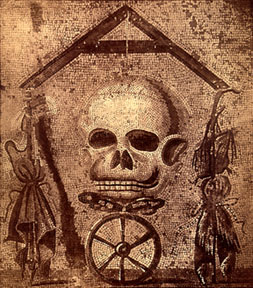
Archive Photo KM 61.8.2294q: Mosaic from Pompeii

The particular 'deaths on display' in this web exhibit are three fictitious Roman grave groups, created from ancient artifacts in the Kelsey Museum of Archaeology at the University of Michigan to illustrate death and burial in the Roman empire. They have been investigated and presented to the public by students enrolled in a first-year seminar at the university (Classical Civilization 120: Death on Display in the Ancient World).
The first-year seminar was intended to introduce its participants to a variety of worlds: the ancient Mediterranean, mortuary archaeology, museums, and museum display. The intersection of these worlds is found in the stories presented in this exhibit. The descriptions and analyses you will read are those of the students in the course.
These grave assemblages, it must be stressed, are imaginary in nature. While all the objects shown and discussed are to be found in the holdings of the Kelsey Museum of Archaeology at the University of Michigan, none of these objects were necessarily found together, and the groupings of material should not be understood to represent real Roman burials. Instead, these were deliberately constructed assemblages, designed to encourage students to think about a variety of topics, including:
Each class group emphasized different aspects of the study of death in the Roman world. The group studying the Roman sarcophagus inhumation of Valeria Callityche became interested in the life history of this woman, who began life as a slave and ended it a free hairdresser (ornatrix). The students analyzing the cremation burial from Puteoli preferred a more impersonal approach, in deference to the actual physical remains with which they dealt. Those working with the grave of a young woman from Terenouthis in Roman Egypt became fascinated by the multi-cultural nature of her grave goods, and thus of the world in which she lived.
Valeria Callityche, Freedwoman - A Classic Roman Inhumation |
Cremation in a Roman Port Town |
Diversity in Death: A Tomb in Terenouthis |
This page created June 1, 1998